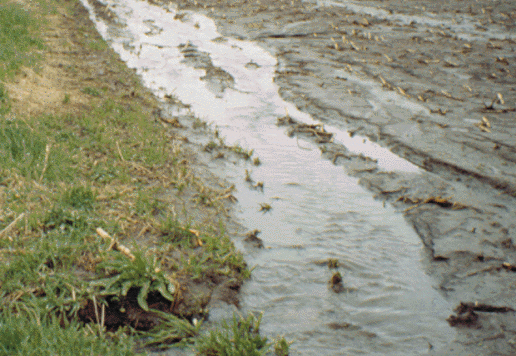The farmer’s attitude towards environmental BMPs
SURVEY SHOWS WIDESPREAD ACCEPTANCE
FARMERS ARE MUCH more likely to consider the environment an important issue than consumers are, says a recent report by Ipsos Marketing. When it comes to environmental Best Management Practices (BMPs), farmers are supportive of regulations and appreciate the fact that those regulations create consumer confidence. Regulations, however, often represent added costs, can restrict the freedom to operate, and create more paperwork. The survey reveals, though, that these burdens would be easier to accept if producers were given credit for the time and money they spend on taking care of the environment.

Colin Siren, Vice President at Ipsos Marketing, presented the survey’s results at a recent Farm & Food Care Ontario event. It found that while consumers placed food safety, health, and affordability as top-of-mind concerns, farmers were much more likely to be concerned about animal welfare and the environment, including soil, air and water quality, and biodiversity.
Farmers tend to be more concerned about topics that could impact their farms’ agronomic success or groundwater safety, says Siren. Top-of-mind issues include the availability of water, loss of soil fertility, and ground water contamination.
On the farm, awareness of programs like the Environmental Farm Plan (EFP) and the Canada-Ontario Farm Stewardship Program (COFSP) is high. In fact, of those surveyed, 92 percent know of EFP’s existence. Sixty-five percent have already completed a plan, and another 13 percent are considering completing it.
“Over the past twenty years, more than 70 percent of Ontario’s farmers have taken the two-day EFP workshop,” says Andrew Graham, Director of Operations, Ontario Soil and Crop Improvement Association. “That’s quite an astounding accomplishment.”
Since it was first introduced in 1993, EFP has had a solid reputation as a great adult education program, says Graham. Now in its fourth edition, the EFP workbook offers participants instruction on how to progress through the Risk Assessment and Action Plan. The Risk Assessment gives the opportunity to rate the current level of environmental concern in up to 23 different areas on the farm. BMPs and regulations are woven into those assessments.
“The EFP Workbook continues to be offered to producers through voluntary workshops supported by Growing Forward 2,” says Graham. “Participant surveys continue to show a very high level of satisfaction with the knowledge gained through the workshop.”
WHAT ARE PRODUCERS DOING WELL?
Over a four-year period (2009-2013), the cost-share program associated with EFP has spent $28-million in both federal and provincial funding on some 6,500 on-farm projects.
Across the list of 28 different BMPs, says Graham, the most popular were precision agriculture (792 projects), water well management (539 projects), upland and riparian area habitat management (529 projects), improved cropping systems (529 projects), and farmyard runoff control (511 projects).
“These top five BMPs represent 44 percent of the total activity and about 39 percent of the total project dollars paid out,” says Graham. “The same five also ranked very high over the four years previous when almost 17,000 projects took advantage of cost-share totaling in excess of $71 million. Farmers are doing a lot of things right on the environmental front, and EFP is helping them along the way.”
Producers regularly face new challenges that influence decisions on production, environment, economic, and social matters. The EFP workbook, as a result, needs to be kept relevant to what farmers face today.
“As of late, current campaigns in the Ministry emphasize the need to keep the soil surface protected twelve months of the year to guard against erosion and fertility loss,” says Graham. “A renewed interest in the role of cover crops as one means to achieve that cover and contribute to soil health, is catching the attention of many who are looking at the practice through a new and innovative lens.”
BMPs that offer a greater economic benefit are generally the ones that see higher uptake, says Micah Shearer-Kudel, Environmental Coordinator with Farm & Food Care Ontario. That’s not to say that farmers will only implement BMPs that save them money or offer a return, he says. Those that do get implemented definitely provide an opportunity to improve the overall economics of the farm.
“When you add windbreaks and reduce erosion, you have better soil,” says Shearer-Kudel. “Better soil, generally, will lead to better yields. A better yield, at the end of the day, is what a farmer wants.”
Shearer-Kudel thinks that managing runoff is one of the lesser-known BMPs.
“Another good example is managing for soil erosion,” he says, “including things like cover cropping, trees, tillage is a big one, and structure.”
“Those are, of course, becoming more popular and they’re still being tested heavily,” he continues. “There’s still a lot of work to be done, but there are already BMPs and opportunities for farmers that might not be as well known.”
In conclusion, the survey found that while adoption of environmental best practices is relatively high (71%), a significant number of Ontario farmers (45%) still fall into the lower adopter category. Areas that need improvement revolve around resource planning.
In order to shift lower adopters to higher adopters, Siren says that it is important to understand the drivers and barriers to implementing environmental best practices. In particular, a better understanding of farmer attitudes, the feasibility of programs, and an increased overall awareness of BMPs should aid farmers in even further adoption.
To learn more about completing an EFP, go to: http://www.ontariosoilcrop.org/en/programs/environmental_farm_plan.htm.
To learn more about the ‘Producer Attitudes Study’ conducted by Farm & Food Care, go to: http://www.farmfoodcare.org/component/content/article/10-farm-food-care/environment/355-producer-attitudes-study-environment.•






















